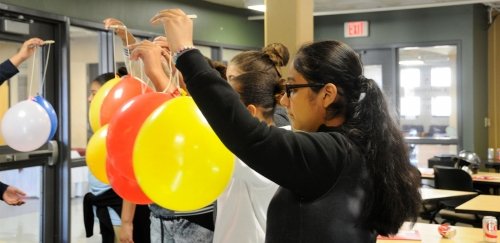Middle School Girls Experiment with STEM Fields at RIC
- News & Events
- News
- Middle School Girls Experiment with STEM Fields at RIC

At the fifth annual STEM in the Middle workshop and career expo, students experiment with the concept of “pressure differential” to discover why airplanes can fly.
According to national studies, girls take more math and science courses than boys, but by middle school, their interest in STEM begins to wane and other things take precedence, such as extracurricular activities and boys, said JoAnn Johnson, director of Tech Collective’s Youth and Education Programs.
Johnson wants to catch girls before they leave the sciences behind, noting that “women take up half of the workforce in the United States but only hold about a quarter of the STEM jobs.”
To inspire girls to participate in and pursue careers in STEM, the Tech Collective held its annual STEM in the Middle workshop and career expo for girls on Nov. 4 at Rhode Island College.
Hosted by the Rhode Island STEAM Center at RIC, 120 students arrived from Sophia Academy, Woonsocket Middle School, Paul Cuffee Middle School and Calcutt Middle School.
Gov. Gina Raimondo delivered a welcome via a pre-recorded message, urging the girls to reach and never limit themselves. “As Rhode Island’s first female governor, I want you to know that there is nothing you can’t do with hard work,” she said.
The girls were also assured by Carol Giurico, director of the STEAM Center, that they “can change the world.” “If you want to cure diseases or prevent people from getting diseases, if you want to become a researcher who finds a cure or a technician who works with researchers, STEM can help you do that,” she said.
Throughout the morning, students engaged in fun, hands-on, STEM activities in three of 12 workshops, the majority of which were facilitated by female professionals in the following STEM fields: computer science, cosmology, biotechnology, engineering, environmental science, marine science and manufacturing technology.
In one workshop, facilitator Glenda Jeffrey of Dassault Systèmes Simulia showed the girls how engineers use computer simulation to build and test prototypes. After displaying a simulated airplane on the computer screen, she explained to them how airplanes can fly by having them experiment with the concept of pressure differential.
“Pressure is around us all the time, which we call atmospheric pressure,” Jeffrey explained.
She then asked the students to hold up two balloons and blow between them. As the balloons blew apart, she told them, “When air is moving, the pressure is lower. The air you blew between the balloons has a lower pressure and is moving faster than the air pressing down on the balloon. This creates a pressure differential and causes the balloons to lift.”
“In the same way, the air flow passing across the top of the plane’s wing is moving faster than the air passing at the bottom of the wing and helps the plane to lift,” she said.
The middle-schoolers enjoyed these and many other experiments. In other workshops, they built an anemometer (an instrument for measuring the speed of the wind or of any current of gas), created computers and robots, and learned what DNA looks like as well as black holes in space.
“The middle school years represent a crucial time of exploration and self-discovery for girls,” Giurico remarked. “STEM in the Middle exposes them to new experiences in a safe and supportive environment. Hopefully, when the girls return to their schools, they will have more understanding of and connection to STEM and STEAM.”
STEM in the Middle is funded by a Real Jobs Rhode Island grant. Volunteer facilitators are employed by Amgen, Dassault Systèmes Simulia, Fidelity Investments, Hasbro, Ocean Exploration Trust, NASA, the Naval Undersea Warfare Center, the Rhode Island State Police, Rhode Island College, TEALS and Tech Collective.
